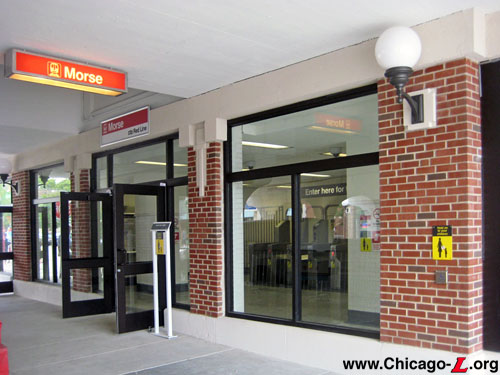
The front entrance to the
Morse station, looking northwest on August 12, 2012 a few days after reopening following renovation. The same Prairie
School elements that Charles Rawson integrated into his
other 1921 North Side-elevation stations are evident here,
though Morse is larger and incorporated more brick into the
exterior. For a larger
view, click here.
(Photo by Graham Garfield)
|
Morse
(6900N/1400W)
Morse Avenue and Glenwood
Avenue, Rogers Park
Service
Notes:

|
Red Line:
Howard |

|
Owl
Service |
Quick Facts:
Address: 1358 W. Morse
Avenue
Established: May 16, 1908
Original Line: Northwestern Elevated Railroad
Previous Names: Rogers Park, Morse-Rogers Park
|
Skip-Stop Type:
|

|
Station
|
Rebuilt: 1921, 2012
Status: In Use
History:
"L" service first entered north Chicago and Evanston by way of an
agreement to use the tracks of the Chicago, Milwaukee and St. Paul
Railway's tracks, replacing the steam service that
the St. Paul had previously provided. The Chicago City Council
authorized the electrification of the tracks of the Chicago,
Milwaukee and St. Paul Railroad's tracks from Graceland Avenue
(Irving Park Road) to the city limits on July 1, 1907. Unlike Evanston (as per the 1907 franchise agreement from the city),
the Chicago City Council did not require that the grade-level tracks
be elevated, but they did prohibit the use of a third rail for
safety's sake, necessitating the use of overhead trolley wire. "L" service north of Wilson to Central Avenue in Evanston began on May 16, 1908.
The St. Paul had a station named Rogers Park at Morse Avenue and Southport Avenue (later Glenwood Avenue). The station, of a style typical of railroad depots, was located on the west side of the tracks on the north side of Morse. As they did at the other stations on the newly electrified line, the Northwestern Elevated Railroad chose not to use the station facilities of the St. Paul steam railroad, which were situated and designed for the needs of a main line commuter railroad rather than a rapid transit service. Instead, the Northwestern built a new station at the same location as the St. Paul's station. The "L" station facility at Rogers Park was a
simple ground-level station and modest platform on the north side of Morse Avenue. The station house was
a small, wood frame building set between the two tracks at ground
level with a wooden walkway and stairs leading up to it from the street. The
exterior used clapboard siding and a hipped roof with eaves. The rear
opened out onto an island platform. The platform had a short canopy with a hipped roof (which was actually a continuation of the station house's roof) and center wooden columns with angled brackets, and wood decking.
Track Elevation, a New Name, and a New Station
In the mid-1910s, the Northwestern Elevated began to elevate the
tracks north from Wilson to Howard, but
work was slow due to the city's refusal to close intersecting streets
and the narrow right-of-way. The elevation work involved complex staging and the temporary relocation of tracks to maintain service while building the new elevated embankment in the same right-of-way. In early 1916, trains were moved onto a
temporary trestle, allowing demolition of the original tracks and stations, but construction of a permanent embankment had to
wait until the end of World War I due to a materials shortage.
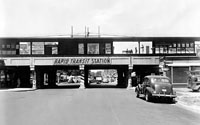
Morse station is seen looking west on Morse Avenue circa the 1940s. Although the details have changed -- the partitions, furniture, and stairway enclosures on the platform; the identification sign on the viaduct; the cars and street lights on the street -- the structure is the same today. For a larger view, click here. (Photo from the CTA Collection) |
With the track elevation came a completely new station. The entrance to the "L" station was located on the north
side of Morse Avenue. The station had a design typical of the
facilities built as part of the Wilson-Howard elevation project.
Designed by architect Charles P. Rawson and engineered by C.F Loweth,
the architectural design was a Prairie School-influenced vernacular
form, with the Prairie influence seen most acutely in the ornamental
cement pilasters on the front facade and in the details of the wooden
doors, windows, and ticket agents' booths. The exterior was brick and
cast concrete with a bedford stone base, wooden doors and large plate
glass windows and transoms. Ornamental globed light fixtures
decorated the pilaster capitals. Morse's station house was centered
within the solid-fill embankment, with retail spaces flanking it on
both sides filling in the remaining width of the embankment.
The interior was rendered in plaster, wood, glazed brick, and
brick with terrazzo floors and plaster ceilings. The walls and columns were clad with white glazed brick to a height 6 feet off the floor, topped with a rounded bullnose trim course and finished with an 8-1/4" art marble molding along the floorline. The remaining walls space to the ceiling was faced in plaster with ornamental plaster trim. In the center of the interior,
passengers found a decorative wooden ticket agent's booth with
ornamental woodwork and a metal grille over the ticket agent's
window. The station also had public restrooms.
There were four tracks through Morse station, but the outer two tracks were for express trains and were not served by the station. A single island platform between the two center tracks served local trains. The platform
had wood decking and a canopy with metal columns down the center line
which split into gently-curving gull wing-shaped roof supports,
supporting a wooden canopy roof. The stairs were sheltered by wooden
enclosures with wooden bottoms and windows on top, divided into rows
of square panes, with swinging doors at the front of each enclosure. Like most of the stations north
of Lawrence, there was originally an
auxiliary exit on the north side of the street, descending down in
the middle of retail spaces built under the elevated, now closed.
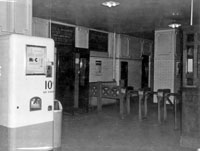
The interior of Morse station is still largely unchanged in this view looking northwest on March 16, 1961. The original glazed brick and plaster walls, including decorative molding above the wainscoting, flooring, lights, and agent's booth are still present here. For a larger view, click here. (Photo from the Graham Garfield Collection) |
By
early 1922, the new four track mainline was completed, allowing full
express service to the city limits.
Around 1940, the station's name changed from Rogers Park to Morse Avenue -- the 1939 map issued by the Chicago Rapid Transit listed the station as the former, but the 1941 map listed it as the latter. Signs at the station, however, listed it as both -- "Morse-Rogers Park" -- from circa the 1920s until KDR
Standard station graphics were installed in the 1970s.
Although the outside tracks (tracks 1 and 4) provided express service and local trains used the inside tracks (tracks 2 and 3), generally making Loyola's single island platform station a stop for local trains, there were some exceptions. The stopping patterns have varied greatly over the years, and with the assistance of a crossover north of the Granville station, some express trains (including the Loyola Express in the pre-CTA era) used to run express south of Granville but ran on the inside tracks between Granville and Howard to stop at Loyola and Morse. In the CTA's North-South service revision, effective July 31, 1949, services were simplified, with Evanston Expresses taking over this role. Evanston Express trains stopped at Morse and Loyola southbound in the morning using Track 2 between Howard and Granville Interlocking, then switched to Track 1 to run express. In the evening, they operated express on Track 4 to Granville, then switched to local Track 3 to stop at Loyola and Morse en route to Howard and Evanston. This continued until December 20, 1976, when Evanston Express trains discontinued stopping at Morse and Loyola. From then on, Evanston Express trains used tracks 1 and 4 at all times south of Howard.
Following complaints from community members and local aldermen Joe
Moore at a CTA annual budget
hearing, viaduct renewal was programmed for Granville and Morse, along with some modest station
improvements at Morse. At each bridge,
deteriorated concrete on the decking and abutments were replaced, the bridge deck was waterproofed and resealed, and
the trackbed and trackwork over the bridge replaced.
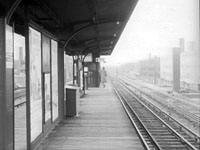
The Morse platform, with its gullwing canopies characteristic of the North Side elevation project, is seen looking north on April 28, 1961. With the exception of additional ads and partitions, the platform appears largely the same as when it was built. For a larger view, click here. (Photo from the Graham Garfield Collection) |
Patching of the spalling concrete on both the Morse and Granville viaducts began in late
September 2004 and was completed in January 2005. At Morse,
work was undertaken in November 2004 to begin renewing the platform
canopy, which was deteriorated and leaking. During the work, various
tracks and portions of the platform were taken out of service during
overnight "owl" hours on different days so that the contractor could perform work
to remove the canopy roof. Occasionally, the main entrance at Morse
Avenue or the Lunt auxiliary entrance would be closed during these
hours as well to accommodate work. By early December 2004, the roof
was completely gone, with only the 1920s steel canopy frame
remaining. The new corrugated metal roof was completed in late
December 2004. The contractor was Kiewit-Western.
In 2006, the station name signs and column signs on the platform
were replaced, with Green Line
Graphic Standard signs replacing the KDR
Standard graphics, and new entrance signs installed as part of a
signage upgrade project on the Red Line. As part of this effort, the
station also received granite compass roses inset into the sidewalk
in front of the station entrance to assist customers leaving the
station to navigate their way, and three-sided galvanized steel
pylons in the station house and on the platform to display maps and
station timetables.
North Red Line Life-Extension Renovations
By the early 21st century, the stations, track, and elevated infrastructure on the north Red Line, between Wilson and Howard, were in severe need of rehabilitation, both to maintain a good state of repair as well as to modernize certain systems and amenities. The scale of the work and the funding necessary to undertake it were large enough that a broad study and planning effort were needed to properly scope the work and apply for sufficient funding. While this study was undertaken, and due to the presumed amount of time it would take to complete the study, secure funding, and complete design engineering, the CTA felt it was necessary to undertake modest-scale renovations in the meantime to extend the life of the existing infrastructure.
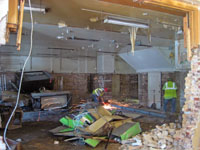
Contractors demolish the interior of the Morse station house during the renovation of the station, seen looking northwest on July 1, 2012. For a larger view, click here. (Photo by Graham Garfield) |
On February 8, 2012, the Chicago Transit Board approved the awarding of a design/build contract to Kiewit Infrastructure Co. to rehabilitate seven rail stations on the North Main Line section of the Red Line: Jarvis, Morse, Granville, Thorndale, Berwyn, Argyle and Lawrence. The work would provide a life-extension for the seven stations until a long-term capital improvement plan is determined for this portion of the Red Line as part of the Red-Purple Modernization Project (see below). "These interim improvements are important because we cannot postpone repairs which need our immediate attention. The CTA wants to be good stewards of the infrastructure we have now, as we continue to plan for the future and pursue additional funding," said CTA President Forrest Claypool. "This contract will allow us to quickly address some much needed capital maintenance work, while also improving the quality and experience for our riders and neighbors."
Kiewit Infrastructure Co. was awarded the contract to through a competitive bid process. Design work began in Spring 2012. Per the terms of the contract, construction was to conclude in early 2013 (though most work was actually completed by the end of 2012) and was not to exceed $57.4 million for services, labor and materials.
Construction plans included temporary station closures for no more than six weeks. Adjacent stations were not closed simultaneously. To minimize impact to customers, service reroutes were scheduled for overnight and weekends only.
Improvement work at each location included renovations to the station facilities, the viaduct, and the tracks. The station houses received new windows, doors and exterior lighting; exterior tuck pointing; improved station layouts; new turnstiles; new interior finishes, including new wall tiling, floors, walls and ceilings; new signage and interior lighting; and site improvements including sidewalk repairs and new bike racks. The platform deck structure and foundation was replaced, the platform fixtures, furnishings and canopy improved, and a new customer communication system installed. Concrete repairs to the viaducts and to the track-level walls were made at each station, and a new waterproofing and drainage system was installed. In addition, the viaducts received painting/coating and new, brighter lighting under the viaducts. New track, ties, and ballast was laid through the station area.1
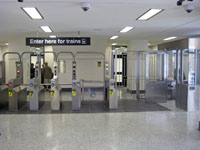
The interior of the renovated Morse station is seen looking north from the front entrance on August 12, 2012. The rehabilitation gutted the interior and installed new terrazzo flooring, wall tiles, cement plaster walls and ceiling, lighting, and fixtures. For a larger view, click here. (Photo by Graham Garfield) |
The exterior masonry, including the brick walls and concrete trim, was cleaned and the brickwork re-tuckpointed. The wooden door and window frames were removed and a new dark brown aluminum storefront installed. New globed lights were installed on the piers.
Inside, the station house was gutted down to the structural shell. The retail space to the west of the station house was retained as rental space, but the retail space flanking the station to the east was demolished and the common wall removed so that the station interior could be expanded into the former concession space. The enlarged station interior allowed for a more open space and improved passenger circulation. A new light gray terrazzo floor was installed on top of a sand cushion. The walls were clad in new white modular glazed brick similar to the original material, though with some difference -- while the walls were originally clad only to a height just over 6 feet from the floor with plaster walls above, nearly all of the renovated station interior's walls were clad in glazed brick up to the new suspended plaster ceiling. Only the free-standing columns, the rear angled wall under the south stairs to the platform, and certain piers along the side walls retained the original design of glazed brick extended up to a height of 6 feet, topped with a rounded bullnose trim, and cement plaster coating the walls above. The original ornamental plaster trim on the plaster walls was not replicated in the renovated station, however. A new Customer Assistant kiosk was also installed, typical of those installed by the CTA at new Brown Line stations and other recent projects like the renovations at North/Clybourn and Cermak-Chinatown, with stainless steel lower walls and roof and glass panels on all side for maximum visibility.
The wooden platform deck was completely removed and new foundations and supports installed to supplement the original structure. A new precast concrete deck was installed, edged with blue tactile panels. The original 1921 platform canopy was retained, stripped, rehabilitated, and repainted. New fixtures including galvanized steel windbreaks and stairway enclosures, new benches, lighting, sandboxes, speakers, and signage were installed.
Installing elevators to make all the stations wheelchair-accessible was not part of the short-term project.2 Work was also performed on the roofs, walls, and storefronts of the adjacent retail spaces in the stations, so that inside concession spaces could be leased and generate revenue for the Authority.3
Morse temporarily closed for renovation at the end of the day June 29, 2012. The station reopened following renovation at 11:59pm, Friday, August 10, 2012. Mayor Rahm Emanuel and CTA President Forrest Claypool dedicated the rehabbed station at an event held across the street at one of the storefronts under the "L" on Tuesday morning, August 14, 2012, joined by Ald. Joe Moore (49th Ward) and State Rep. Kelly Cassidy (14th District).
After beginning to undertake rehabilitation work on the storefront on the west side of the Lunt auxiliary entrance in July 2012, it was determined that the structure was in deficient condition, requiring its demolition. The project budget did not have sufficient funds to completely rebuild the storefront, so the CTA worked with Alderman Moore and the community to determine a new use for the space.4 The CTA began demolition of the storefront the week of September 16, 2012. In mid-September, the alderman announced that the CTA and his office developed a plan to create a "bicycle parking lot" for the area in the space formerly occupied by the storefront. The space, partially underneath the elevated track viaduct, will received a new concrete slab floor and new masonry knee wall at the northwest corner of the site, on the southeast corner of Lunt and Glenwood (West), with an 8" cast stone base, brick facing to match the existing station and former storefront, and topped with a 2" cast stone cap. Six-foot high black ornamental fencing will enclose the site, which will be outfitted with bike racks and receive extensive lighting.5
Funding for the station rehabilitation project is from the Federal Transportation Administration (FTA) and is part of the $1 billion Red Line investment project. The $1 billion capital investment is a combination of state, local and federal funds, which will support other Red Line projects including track and station renewal along the Dan Ryan branch; the renovation of the Clark/Division and Wilson stations; and several other track, substation and station renewal projects along the North Side Main Line.
Red-Purple Lines Modernization (RPM) Project
Due to the deteriorating condition of the infrastructure on the Red Line north of Belmont and on the Purple Line, the CTA initiated the Red-Purple Modernization Project (RPM) to bring the existing transit stations, track systems, and structures into a state of good repair. The project, which stretches along the existing Red and Purple lines from north of Belmont station to Linden terminal, would help bring the existing transit line into a state of good repair, reduce travel times, improve access to job markets and destinations, and provide improved access to people with disabilities.
The project began in 2009 with a vision study to assess the scope of needs and develop a set of alternatives for study. In 2010, in accordance with the National Environmental Policy Act (NEPA), CTA and Federal Transit Administration (FTA) initiated the environmental review process for the project and undertook work to develop an Environmental Impact Statement (EIS). The process included numerous public meetings and input opportunities, and study of various alternatives for achieving a good state of repair for the infrastructure in the project area.
A number of alternatives are under consideration for the RPM project, including the comprehensive reconstruction of track, stations, and structures along the line. The four options currently under consideration and study, not including an FTA-required "no action" baseline scenario, include:
- Basic Rehabilitation: provides a strategic mix of repairs, rehabilitation, and replacement of the existing infrastructure for a useful life of 20 years, plus the addition of a transfer station at Loyola; all station locations remain the same.
- Modernization with Station Consolidation: provides a brand new elevated structure between Lawrence and Howard, modern amenities at stations, increases speed of service, includes new transfer station at Loyola, and major reconstruction and renovation to extend the useful life to 60-80 years; several stations would be consolidated by closing one station and adding a second entrance at an adjacent station.
- Modernization without Station Consolidation: provides a brand new elevated structure between Lawrence and Howard, modern amenities at stations, modest increase in speed of service, includes new transfer station at Loyola, and major reconstruction and renovation to extend the useful life to 60-80 years; all station locations remain the same.
Other alternatives considered earlier in the study but subsequently eliminated due to public comment and further study included basic rehabilitation without adding a transfer station at Loyola, a modernization option with only three tracks between Lawrence and Howard, and a modernization option with a 2-track subway under Broadway.
The full-scale modernization envisioned on the Red-Purple Modernization Project could cost anywhere from $2.5 to $5 billion. On February 8, 2012, the CTA board retained Goldman Sachs & Co. to lead the search for public-private partnerships to help finance the reconstruction, which has no firm date. Goldman Sachs will work with Chicago-based Loop Capital Markets LLC and Estrada Hinojosa & Co., but will accept no fee for the first year as it determines the ability to raise private capital.
See CTA's Red & Purple Modernization page for more information about the scoping and planning process, and the various alternatives being considered.
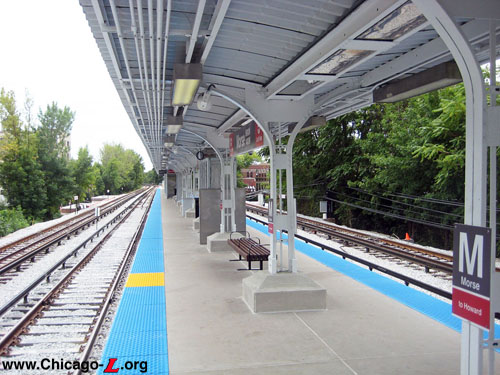
The Morse island platform,
looking south on August 12, 2012, following renovation. The gullwing canopy is original to the 1921 station, but the recent rehabilitation replaced the wood platform deck with precast concrete, refurbished the canopy structure, and provided new platform signage and furniture. For a larger
view, click here.
(Photo by Graham Garfield)
|

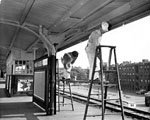
|
morse02.jpg
(191k)
CTA painters apply a fresh coat of dark green and cream paint to the Morse Avenue "L" station in 1955. Station signage used to be much more descriptive geographically: the station is identified as "Morse-Rogers Park". (Photo from the CTA Collection)
|
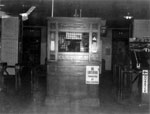 |
morse04.jpg (99k)
The station's 1921-vintage ticket agent's booth is seen inside Morse station on March 16, 1961. The booth in this view is still almost completely unchanged from when it was built, and most of the station's other original ornamentation and appointments are also visible in the background. Note the fare registers mounted on the sides of the booth, and that while there are turnstiles present to channel exiting passengers and service those paying with exact fare or tokens, the booth has no turnstiles, something not uncommon long into the CTA era. (Photo from the Graham Garfield Collection) |
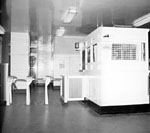 |
morse06.jpg (74k)
The interior of Morse station is seen here looking north in 1971. Compared to the view 10 years earlier above, the interior is largely the same but the details but begun to change with the times -- incandescent lights replace with fluorescent fixtures, plexiglas partitions, and the wooden ticket agent's booth painted white, all to present a brighter, more "modern" appearance. (CTA photo, from the Graham Garfield Collection) |
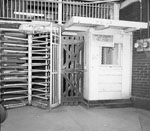 |
morse.lunt01.jpg (97k)
The Lunt auxiliary entrance at Morse station is seen looking south in 1971. At the time, the Lunt facility was available for exiting at all times but was only a part-time entrance, staffed during weekday morning rush hours only. When open for entry, the small ticket agent's booth would be staffed and that tall narrow gate next to it opened to allow entry. There was no turnstile for entering customers. (CTA photo, from the Graham Garfield Collection) |
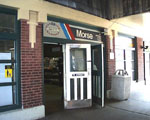 |
morse07.jpg (103k)
The front entrance to the Morse station, looking north in 1999. The "Spirit of '76" sign over the entrance is left over from the Bicentennial, during which the CTA decorated many of its rail cars in a similar scheme.. (Photo by Graham Garfield) |
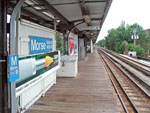 |
morse08.jpg (274k)
The Morse platform is a mixture of elements of various vintages by the time of this July 14, 2005 view looking north. The basic structure and gullwing canopy are original from the station's 1921 construction, as are some f the wooden partitions. Other elements were added over time, such as the 1980s-vintage signage. The canopy roof -- originally a wood-panelled base with a "built-up" membrane composed of alternating layers of bitumen, tar, and reinforcing fabrics -- was replaced with a new corrugated metal covering in 2004, a short time before the photo was taken. (Photo by Graham Garfield) |
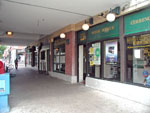
|
morse09.jpg (224k)
The Morse station house is seen looking northwest along Morse Avenue on July 14, 2005, with the station entrance in the center flanked on either side by storefronts. The Chicago, St. Paul and Milwaukee Railroad (who owned the line and leased it to the Northwestern Elevated, and later the Rapid Transit Company and CTA) designed the North Side elevation stations to have retail space around the stations both for passenger amenities and added income. Although the basic structure and masonry facing and ornamentation remains original, both the storefront and the station entrance have bee modified over time with new or altered window and door frames and new lights. (Photo by Graham Garfield)
|
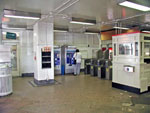 |
morse10.jpg (262k)
The interior of the Morse station, seen looking northwest in the unpaid area on July 14, 2005, still has most of its original materials and appointments such as the terrazzo floors, glazed brick and plaster walls with decorative moldings, and vintage ticket agent's booth. Time and heavy usage have taken their toll, however, and a number of small changes and additions have also served to give the station a well-worn appearance. (Photo by Graham Garfield) |
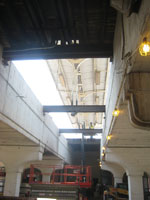
|
morse12.jpg (160k)
Demolition of the elements to be replaced are well underway at Morse station on July 2, 2012, a couple days after the station closed for six weeks for renovation. The wooden platform deck was replaced with a new precast concrete deck as part of the work. Daylight pours into the viaduct over Morse Avenue, looking up between the two track viaducts over street where the removal of the wooden platform deck has opened up the space between the tracks. (Photo by Graham Garfield)
|
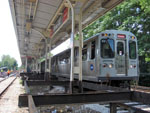 |
morse13.jpg (278k)
A Howard-bound train passes the closed Morse station on July 2, 2012 (operating against traffic on Track 2, due to the closure of Tracks 3 and 4 for viaduct renewal and waterproofing and track replacement) where the old wooden decking and joists have been removed, leaving only the steel canopy structure and support stringers, which would be refurbished, reinforced, and reused in the new station. After additional supports were installed, a new precast concrete deck was erected. (Photo by Graham Garfield) |
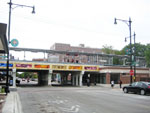
|
morse14.jpg (199k)
Morse station is seen looking west on Morse Avenue and Glenwood Avenue on August 12, 2012, following closure for six week for renovation. The rehabilitated station house with cleaned and repaired masonry and the renovated platform with improved canopy and new windbreaks, stairway enclosures, signage, and other fixtures are all on display. (Photo by Graham Garfield)
|
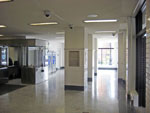 |
morse17.jpg (181k)
The renovated interior of the Morse station house is seen looking east in the unpaid area on August 12, 2012. This view looks into the expanded footprint of the station interior, which was formerly a separate retail space but whose common wall was removed so the station could expand into that area. The interior features new terrazzo floors, tile and plaster walls, plaster ceilings, a new Customer Assistant kiosk, security cameras, and new signage and other fixtures. (Photo by Graham Garfield) |
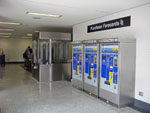
|
morse18.jpg (189k)
The farecard vending machines in the renovated Morse station are located in the newly-expanded portion of the interior footprint on the east side of the station, in space that was formerly a retail concession space. By moving the farecard vending away from the old station footprint more room was providing for customers using the machines and queues forming behind them, and congestion around the turnstiles was reduced. This view looking northwest on August 12, 2012. (Photo by Graham Garfield)
|
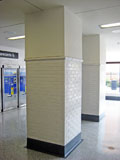 |
morse19.jpg (174k)
In the original 1921 station interior, the walls and columns were clad with white glazed brick to a height 6 feet off the floor, topped with a rounded bullnose header course. The remaining walls space to the ceiling was faced in plaster with decorative molding panels, with an 8-1/4" art marble molding along the floorline. As seen in this view looking east inside the Morse station house on August 12, 2012, the renovated interior mimics this design with new materials, but with some modifications. The columns in the station house are clad in materials and in a style very similar to those that were removed, with a new base molding of dark precast terrazzo and white glazed tile topped with a rounded bullnose trim course to a point just over 6 feet off the floor and cement plaster above (without the decorative moldings, however) . On the walls, however (visible in the background), the plaster course above the tiling was omitted and the new glazed tiles extend all the way to the ceiling. (Photo by Graham Garfield) |
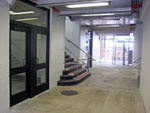
|
morse20.jpg (190k)
The foyer behind the station house at the base of the stairs to the platform was not heavily modified in the renovation, but was given a new poured concrete floor, cleaned and painted brick walls, and new doors and frames on the station house. The stairs were repaired and its handrails replaced with new stainless steel fixtures. The metal ceiling and light system was installed in the 2004 improvement work and left in place. Unlike most north Red Line stations where this space is inside the station house, this space at Morse is more "outdoor" in character, with exit rotogates leading out to both Glenwood Avenues that flank the embankment here, the west rotogate seen in the background of this view looking west on August 12, 2012. (Photo by Graham Garfield)
|
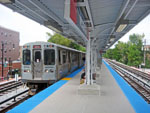 |
morse21.jpg (248k)
The refurbished Morse station platform is seen looking north from the south end of the station as a 95th-bound Red Line train prepares to depart on August 12, 2012. The platform renovation included a refurbished canopy and new precast concrete deck. (Photo by Graham Garfield) |
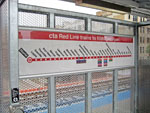
|
morse22.jpg (332k)
As part of the signage package for the renovated station, Morse received the system's first of these smaller horizontal directional line diagram signs, one of the ones for the 95th-bound direction seen in a windbreak south of the stairs from the station house on August 12, 2012. The signs are similar to the horizontal diagrams found at certain subway stations, but are smaller to fit inside windbreaks. The signs provide wayfinding guidance to customers by providing a geographically-ordered list of all the stations between the current location and one of the terminals, supplementing the directional signs that only list the end terminal. (Photo by Graham Garfield)
|
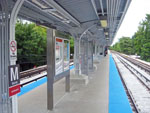 |
morse23.jpg (272k)
The Morse station platform is seen looking north on August 12, 2012. The station renovation included refurbishing the steel canopy structure, installing a new precast concrete platform with tactile edging, new windbreaks, and new signage. The platform's triangular information pylon was replaced with a new, flat information panel. (Photo by Graham Garfield) |
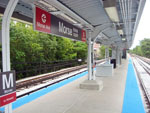
|
morse24.jpg (272k)
The renovated Morse station platform included new station symbol signs on the columns as well as new name signs with exit wayfinding information in the colored tabs on those between the Morse and Lunt exits, seen looking north on August 12, 2012. The large angle concrete bases where the canopy columns meet the new platform result from work to shore up and reinforce the old canopy to create a new support footing. (Photo by Graham Garfield)
|
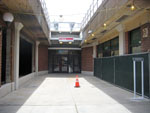 |
morse.lunt02.jpg (176k)
The Lunt auxiliary entrance to Morse station is seen looking south on August 12, 2012. The farecard High-Barrier Gate (HBG) turnstile is just inside the doors, which protect it from rain and other weather elements. Although open for service at the time of the photo, construction work was still ongoing at the retail spaces the flank the corridor leading to the auxiliary entrance. (Photo by Graham Garfield) |

|

|
Notes:
1. Red North Station Interim Improvements webpage. Chicago Transit Authority, retrieved 25 March 2012.
2. Hilkevitch, Jon. "$57.4 million facelift program OK'd for 7 North Side stops on CTA's Red Line." Chicago Tribune. 8 February 2012.
3. Roberts, Bob. "Major Renovations Coming To Multiple Red Line Stations." CBS Chicago. 9 February 2012.
4. "West Storefront at Lunt Entrance to be Demolished". ward49.com. Posted July 30, 2012. Accessed October 21, 2012.
5. "West Storefront at Lunt CTA Entrance to be Demolished this Week". ward49.com. Posted September 18, 2012. Accessed October 21, 2012.





























